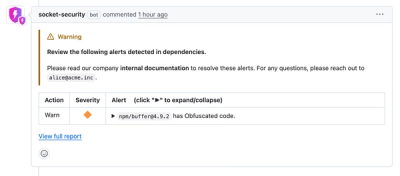
Security News
Crates.io Users Targeted by Phishing Emails
The Rust Security Response WG is warning of phishing emails from rustfoundation.dev targeting crates.io users.
react-firebaseui
Advanced tools
React wrapper for firebaseui: Javascript library for customizable UI on top of Firebase SDK
FirebaseUI React Components provides React Wrappers on top of the Firebase UI Web library and notably Firebase UI Auth.
FirebaseUI Auth provides a drop-in auth solution that handles the UI flows for signing in users with email addresses and passwords, and Identity Provider Sign In using Google, Facebook and others. It is built on top of Firebase Auth.
For an example on how to use the FirebaseAuth react component have a look at the example folder.
Install the npm package in your React app:
npm install --save react-firebaseui
You also need the firebase package installed which is a peer dependency:
npm install --save firebase
In your app:
FirebaseAuth or the StyledFirebaseAuth component from react-firebaseui and import firebase.FirebaseAuth component in your template passing it the Firebase UI configuration and a Firebase Auth instance.FirebaseAuth vs. StyledFirebaseAuthThere are two similar components that allow you to add FirebaseUI auth to your application: FirebaseAuth and StyledFirebaseAuth.
FirebaseAuth has a reference to the FirebaseUI CSS file (it requires the CSS).StyledFirebaseAuth is bundled with the CSS directly.For simplicity you should use StyledFirebaseAuth and for potential better performances and build sizes you can use FirebaseAuth. FirebaseAuth is meant to be used with a CSS/style loader as part of your webpack built configuration. See the Packing your app section.
StyledFirebaseAuth with a redirectBelow is an example on how to use FirebaseAuth with a redirect upon sign-in:
// Import FirebaseAuth and firebase.
import React from 'react';
import StyledFirebaseAuth from 'react-firebaseui/StyledFirebaseAuth';
import firebase from 'firebase/compat/app';
import 'firebase/compat/auth';
// Configure Firebase.
const config = {
apiKey: 'AIzaSyAeue-AsYu76MMQlTOM-KlbYBlusW9c1FM',
authDomain: 'myproject-1234.firebaseapp.com',
// ...
};
firebase.initializeApp(config);
// Configure FirebaseUI.
const uiConfig = {
// Popup signin flow rather than redirect flow.
signInFlow: 'popup',
// Redirect to /signedIn after sign in is successful. Alternatively you can provide a callbacks.signInSuccess function.
signInSuccessUrl: '/signedIn',
// We will display Google and Facebook as auth providers.
signInOptions: [
firebase.auth.GoogleAuthProvider.PROVIDER_ID,
firebase.auth.FacebookAuthProvider.PROVIDER_ID,
],
};
function SignInScreen() {
return (
<div>
<h1>My App</h1>
<p>Please sign-in:</p>
<StyledFirebaseAuth uiConfig={uiConfig} firebaseAuth={firebase.auth()} />
</div>
);
}
export default SignInScreen
StyledFirebaseAuth with local state.Below is an example on how to use StyledFirebaseAuth with a state change upon sign-in:
// Import FirebaseAuth and firebase.
import React, { useEffect, useState } from 'react';
import StyledFirebaseAuth from 'react-firebaseui/StyledFirebaseAuth';
import firebase from 'firebase/compat/app';
import 'firebase/compat/auth';
// Configure Firebase.
const config = {
apiKey: 'AIzaSyAeue-AsYu76MMQlTOM-KlbYBlusW9c1FM',
authDomain: 'myproject-1234.firebaseapp.com',
// ...
};
firebase.initializeApp(config);
// Configure FirebaseUI.
const uiConfig = {
// Popup signin flow rather than redirect flow.
signInFlow: 'popup',
// We will display Google and Facebook as auth providers.
signInOptions: [
firebase.auth.GoogleAuthProvider.PROVIDER_ID,
firebase.auth.FacebookAuthProvider.PROVIDER_ID
],
callbacks: {
// Avoid redirects after sign-in.
signInSuccessWithAuthResult: () => false,
},
};
function SignInScreen() {
const [isSignedIn, setIsSignedIn] = useState(false); // Local signed-in state.
// Listen to the Firebase Auth state and set the local state.
useEffect(() => {
const unregisterAuthObserver = firebase.auth().onAuthStateChanged(user => {
setIsSignedIn(!!user);
});
return () => unregisterAuthObserver(); // Make sure we un-register Firebase observers when the component unmounts.
}, []);
if (!isSignedIn) {
return (
<div>
<h1>My App</h1>
<p>Please sign-in:</p>
<StyledFirebaseAuth uiConfig={uiConfig} firebaseAuth={firebase.auth()} />
</div>
);
}
return (
<div>
<h1>My App</h1>
<p>Welcome {firebase.auth().currentUser.displayName}! You are now signed-in!</p>
<a onClick={() => firebase.auth().signOut()}>Sign-out</a>
</div>
);
}
export default SignInScreen;
To allow for further configuration you can access the firebaseUI instance before it is started.
To do this you can pass a uiCallback callback function that wil be passed the Firebase UI instance. For example here is how to enable the disableAutoSignIn() option:
// ...
return (
<div>
<h1>My App</h1>
<p>Please sign-in:</p>
<StyledFirebaseAuth uiCallback={ui => ui.disableAutoSignIn()} uiConfig={uiConfig} firebaseAuth={firebase.auth()}/>
</div>
);
If you are using the StyledFirebaseAuth component there should not be special configuration needed to package your app since the CSS is already included within the component. if you would like to extract the CSS you should use the FirebaseAuth component instead.
The FirebaseAuth needs a global CSS to get proper styling. The CSS is already imported within FirebaseAuth.
If you are using webpack you'll need to add CSS loaders:
{
module: {
rules: [
{
test: /\.css/,
use: [ 'style-loader', 'css-loader' ]
}
]
}
}
PS: make sure your rule does not exclude /node_modules/ as this is where the library, and therefore, the CSS is located.
If you are using ExtractTextPlugin to extract a CSS file from the required CSS files you would typically use:
{
plugins: [new ExtractTextPlugin('./bundle.css')],
module: {
rules: [
{
test: /\.css/,
loader: ExtractTextPlugin.extract(
{
fallback: 'style-loader',
use: ['css-loader']
})
}
]
}
}
PS: make sure your rule does not exclude /node_modules/ as this is where the library, and therefore, the CSS is located.
If you are using CSS modules in your app you need to handle the CSS files in /node_modules/ in a separate loader so that they are imported as global CSS files and not modules. Your setup could look like:
{
plugins: [new ExtractTextPlugin('./bundle.css')],
module: {
rules: [
// CSS loaders for CSS modules in your project. We exclude CSS files in ./node_modules
{
test: /\.css$/,
exclude: [/\.global\./, /node_modules/],
loader: ExtractTextPlugin.extract(
{
fallback: 'style-loader',
use:[
{
loader: 'css-loader',
options: {
importLoaders: 1,
modules: true,
autoprefixer: true,
minimize: true,
localIdentName: '[name]__[local]___[hash:base64:5]'
}
}
]
})
},
// CSS loaders for global CSS files which includes files in ./node_modules
{
test: /\.css/,
include: [/\.global\./, /node_modules/],
loader: ExtractTextPlugin.extract(
{
fallback: 'style-loader',
use: ['css-loader']
})
}
]
}
}
To change the styling of the FirebaseAuth or the StyledFirebaseAuth widget you can override some of its CSS. To do this, import a CSS that will be included in your packed application. For instance create a firebaseui-styling.global.css file and import it in your app:
import './firebaseui-styling.global.css'; // Import globally. Not with CSS modules.
Note: If you are using the With ExtractTextPlugin and CSS modules Webpack build rule above, the
.global.csssuffix will make sure the CSS file is imported globally and not ran through modules support.
If you would like to see an example of styling, have a look at the example app.
Alternatively you can include the styling in a <style> tag in your application's markup.
FirebaseUI React cannot be rendered server-side because the underlying, wrapped library (FirebaseUI) does not work server-side.
You can still import and include this library in an app that uses SSR: there should be no errors but no elements will be rendered.
We'd love that you contribute to the project. Before doing so please read our Contributor guide.
© Google, 2011. Licensed under an Apache-2 license.
FAQs
React wrapper for firebaseui: Javascript library for customizable UI on top of Firebase SDK
We found that react-firebaseui demonstrated a not healthy version release cadence and project activity because the last version was released a year ago. It has 3 open source maintainers collaborating on the project.
Did you know?

Socket for GitHub automatically highlights issues in each pull request and monitors the health of all your open source dependencies. Discover the contents of your packages and block harmful activity before you install or update your dependencies.

Security News
The Rust Security Response WG is warning of phishing emails from rustfoundation.dev targeting crates.io users.

Product
Socket now lets you customize pull request alert headers, helping security teams share clear guidance right in PRs to speed reviews and reduce back-and-forth.

Product
Socket's Rust support is moving to Beta: all users can scan Cargo projects and generate SBOMs, including Cargo.toml-only crates, with Rust-aware supply chain checks.